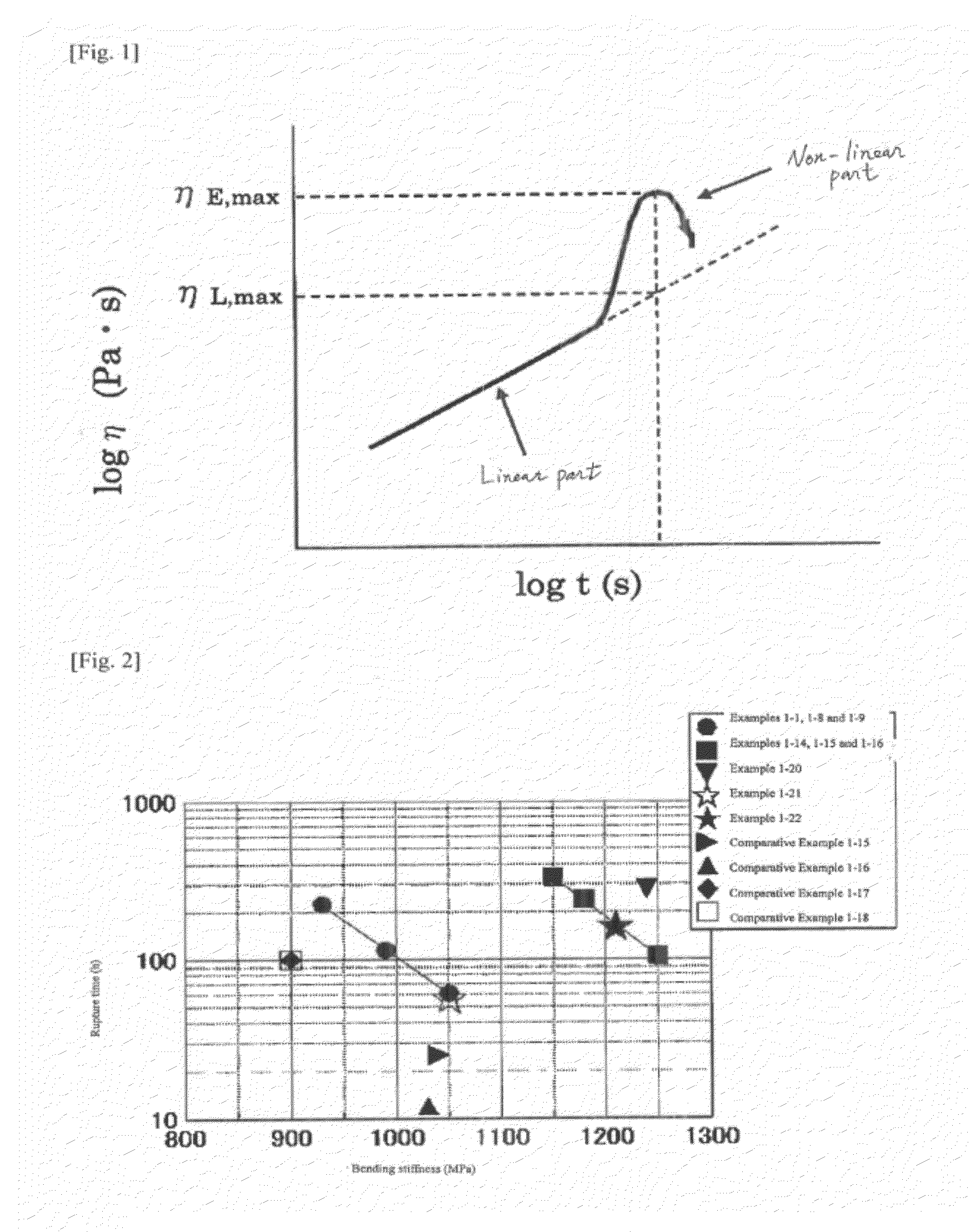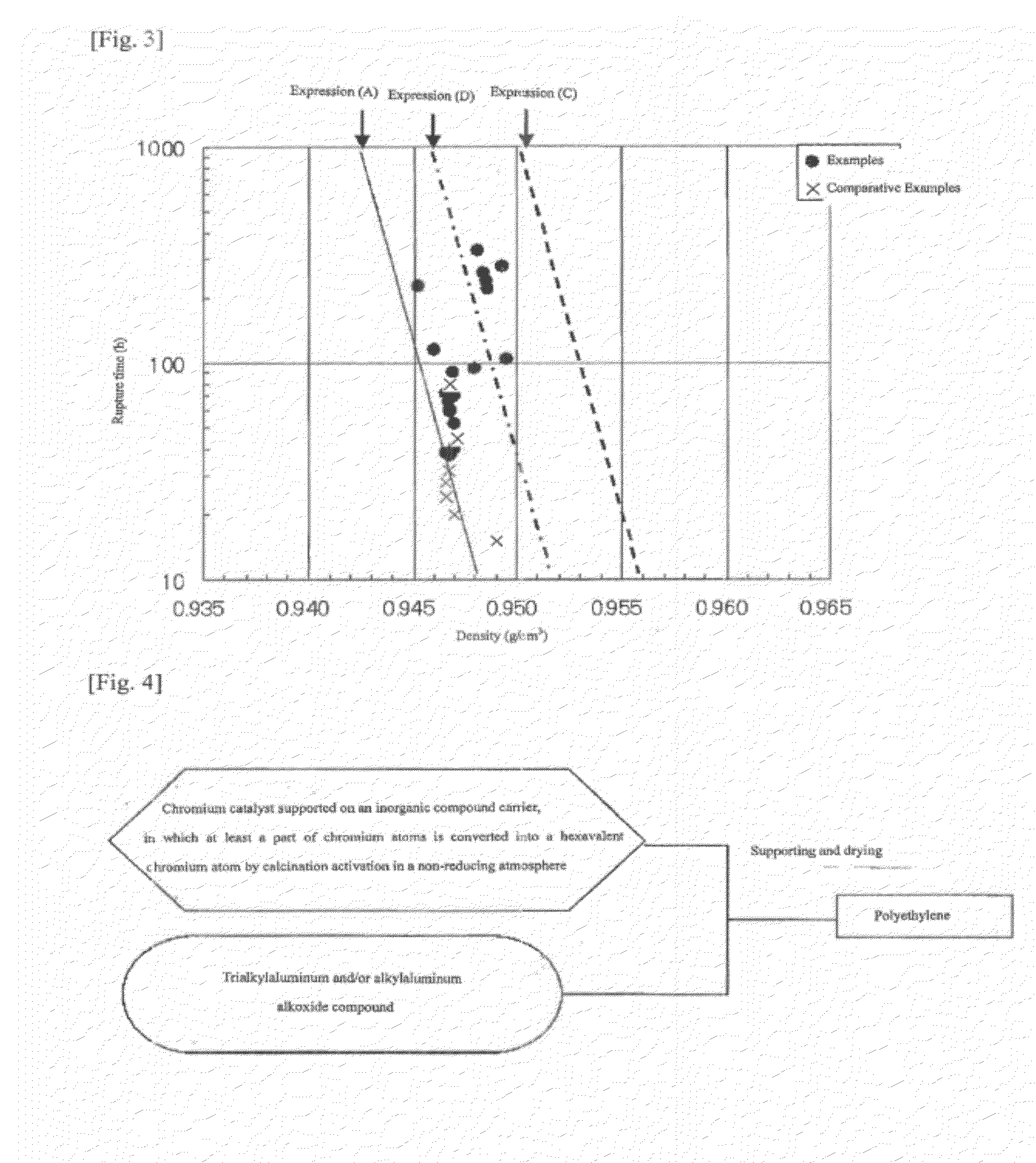Polyethylene based resin, producing catalyst for the same, method for producing the same, hollow plastic molded article containing polyethylene based resin, and use of the same
a polyethylene based resin and catalyst technology, applied in the direction of catalyst activation/preparation, rigid containers, packaging, etc., can solve the problems of low mechanical strength of barrier layer, insufficient durability of hollow plastic molded articles, and insufficient intercepting action of polyethylene containers, etc., to achieve excellent balance, excellent moldability and durability
- Summary
- Abstract
- Description
- Claims
- Application Information
AI Technical Summary
Benefits of technology
Problems solved by technology
Method used
Image
Examples
example 1-1
(1) Preparation of Chromium Catalyst:
[0317]15 g of Catalyst-1 (a catalyst having chromium acetate supported on silica) having a chromium atom supporting amount of 1.1% by weight, a specific surface area of 500 m2 / g and a pore volume of 1.5 cm3 / g was charged in a perforated grating plate-equipped quartz glass tube having a tube diameter of 5 cm; the quartz glass tube was set in a cylindrical electric furnace for calcination; and the catalyst was fluidized with air having passed through a molecular sieve and then subjected to calcination activation at a linear velocity of 6 cm / s at 500° C. for 18 hours. There was thus obtained a chromium catalyst assuming an orange color demonstrating that it contained a hexavalent chromium atom.
(2) Trialkylaluminum Compound-Supported Chromium Catalyst:
[0318]In a 100-mL flask which had been previously purged with nitrogen, 2 g of the chromium catalyst obtained in the foregoing (1), to which was then added 30 mL of hexane which had been purified by dis...
example 1-2
[0320]A trialkylaluminum compound-supported chromium catalyst was prepared, and polymerization was performed in exactly the same manner as in Example 1-1, except that 4.2 mL of a 0.1 moles / L hexane solution of triethylaluminum, manufactured by Tosoh Finechem Corporation (Al / Cr molar ratio=1) was added in place of the tri-n-butylaluminum solution. Polymerization activity was 3,700 g-polymer / g-catalyst / h. Measurement results of physical properties are shown in Tables 1 and 2.
example 1-3
[0321]A trialkylaluminum compound-supported chromium catalyst was prepared, and polymerization was performed in exactly the same manner as in Example 1-1, except that 4.2 mL of a 0.1 moles / L hexane solution of triisobutylaluminum, manufactured by Tosoh Finechem Corporation (Al / Cr molar ratio=1) was added in place of the tri-n-butylaluminum solution. Polymerization activity was 4,000 g-polymer / g-catalyst / h. Measurement results of physical properties are shown in Tables 1 and 2.
PUM
| Property | Measurement | Unit |
|---|---|---|
| molecular weight distribution | aaaaa | aaaaa |
| Charpy impact strength | aaaaa | aaaaa |
| rupture time | aaaaa | aaaaa |
Abstract
Description
Claims
Application Information
 Login to View More
Login to View More - R&D
- Intellectual Property
- Life Sciences
- Materials
- Tech Scout
- Unparalleled Data Quality
- Higher Quality Content
- 60% Fewer Hallucinations
Browse by: Latest US Patents, China's latest patents, Technical Efficacy Thesaurus, Application Domain, Technology Topic, Popular Technical Reports.
© 2025 PatSnap. All rights reserved.Legal|Privacy policy|Modern Slavery Act Transparency Statement|Sitemap|About US| Contact US: help@patsnap.com



